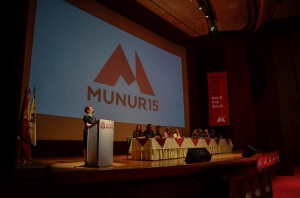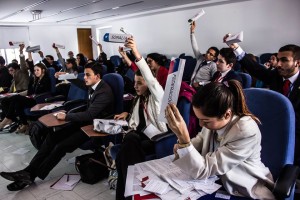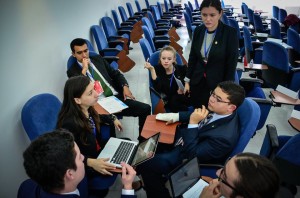Over 500 delegates participated in University of Rosario Model of United Nations (MUNUR) on November 6th to 9th in Bogota, Colombia. On this 6th annual session, MUNUR had the opportunity to host 7 international delegations coming from countries such as Peru, Germany, United States and Argentina.
For this year edition, MUNUR introduced for the first time in Colombia a procedure highly focused in negotiation, allowing delegates to enter and exit the committee room in order to discuss privately with other delegates their strategies, ideas and plans.
MUNUR offered 14 different committees, including 2 historical committees (San Francisco Conference and the General Agreement on Tariffs and Trade of 1947) 2 crisis committees (Joint Crisis Committee: La Resistance Francese vs The Council of People’s Commissars and International Monetary Fund 2008 Crisis) and 1 futuristic committee (UN Space Agency 2050).
Behind the Conference: Interview with MUNUR 2015 Secretary-General and Director-General.
Secretary-General Camilo Blanco: MUNUR was a conference that was structured from ground-zero facing multiple challenges. The most important one was that the project was not sponsored by the University, because in its last sessions it had different issues regarding financing and the financial balance. Then, the structure of the conference had to be developed from zero, making really though the organization of the conference.
Director-General Maria Camila David: MUNUR faced two significant challenges. One of those was to keep working as a team, even when problems had risen. Some problems represent challenges to our friendships, but the MUNUR team managed to overcome them and save all friendships. A second challenge that MUNUR faced was how to handle issues with the event’s budget. Unfortunately, MUNUR did not receive the amount of sponsors and donations it had hoped for, so delegate or social event cuts were considered, but eventually there was no need for any of those alternatives.
How did MUNUR 2015 leave you feeling?
Secretary-General Camilo Blanco:MUNUR left me an important sense of responsibility and reaffirmed the necessity to work with a team in order to accomplish big objectives, each day of the conference this element was reaffirmed by the work of each member of the secretariat and the organization. I believe that Model UN can teach a lot of things, however the organization of a conference requires to learn and be open to tough experiences that normally are not part of a delegate experience. Hence, MUNUR showed me the importance of team work and the resilience that is necessary to affront challenges.
Director-General Maria Camila David: I learned a lot about myself during MUNUR. One aspect I learned about me was how to handle working under very stressful situations that kept happening during the model. I also learned the importance of having a leader in a project like MUNUR. There were times when I felt too tired or frustrated, when I needed to focus on other responsibilities I had or I just wanted to give my position to someone else and call it a day, However, I learned that a leader puts the project before any personal needs or activities, and I decided to keep on working for my team and the project, getting a very successful result.
What is the future of MUNUR?
Secretary-General Camilo Blanco: MUNUR was though as a long term project, in which the ideals of the United Nations could be lived and enforced. Hence MUNUR has a lot of things to work on in order to achieve the objective I mentioned before. I should recall three elements that are fundamental in MUNUR’s projection; the first one is the hard work to establish the conference as one of the most important MUN in Latin America, with at least 600 participants for next year and a continual expansion of the number of delegates present in the conference by each session. The second element is the projection of MUNUR as a conference for any kind of delegate, from a GA delegate to a crisis one, where the experiences and the knowledge will sum up an unique experience that could transform people’s perspective of MUN and problems in the international system. The third element is the projection of MUNUR as a conference for any educational level, then in this conference High School delegates can interact with college delegates, giving the conference an important educational value, where a community is created through the MUN to teach different topics and challenge the delegate’s skills.





